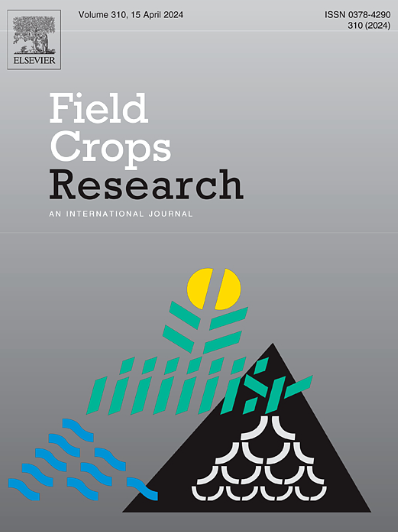Effects of combined high temperature and water stress on soybean growth and physiological processes in a temperature gradient chamber
IF 5.6
1区 农林科学
Q1 AGRONOMY
引用次数: 0
Abstract
Context or problem
Under global warming and growing water scarcity, soybean frequently faces concurrent high temperature stress and water stress, which together impair biomass accumulation and physiological performance. Although the separate effects of high temperature stress or water stress are well documented, their combined impact across realistic temperature gradients remains poorly defined, making it difficult to predict crop performance under simultaneous stresses.
Objective or research question
This study assessed how combined high temperature stress and water stress affect soybean above-ground dry matter accumulation, growth dynamics, physiological processes, and water use efficiency to elucidate the mechanisms combined stress responses.
Methods
A two-year experiment (2023–2024) was conducted in a temperature gradient chamber divided into four thermal zones—low, medium-low, medium-high, high—and two irrigation regimes: normal irrigation and water stress. Above-ground dry matter was determined at harvest, and periodic measurements of leaf area and dry weight were used to derive growth rate and net assimilation. Key physiological processes were monitored throughout development. Relationships among physiological and growth parameters were analyzed using regression and multivariate methods. Water use efficiency was defined as dry matter produced per unit of irrigation water.
Results
Water stress reduced above-ground dry matter by 39–40 % compared with normal irrigation, and the high-temperature zone produced 35–36 % less dry matter than the low-temperature zone. Combined high temperature stress and water stress caused over a 60 % decline in dry matter relative to the low-temperature zone under normal irrigation. Before beginning pod stage, net assimilation rate and crop growth rate were strongly correlated, indicating that assimilation drives early biomass accumulation. Under simultaneous high temperature and water stress, reductions in leaf water potential led to lower stomatal conductance and photosynthetic rate, which in turn suppressed net assimilation, growth, and water use efficiency. Although water stress alone increased water use efficiency in 2023, elevated temperature stress in 2024 reversed this effect under water stress, demonstrating that high temperature stress exacerbates water stress’s negative impact on water use efficiency.
Conclusions
Simultaneous high temperature stress and water stress severely limit soybean biomass by disrupting leaf water potential, stomatal regulation, and photosynthetic performance. The water stress-induced improvement in water use efficiency is negated under elevated temperatures, amplifying biomass loss.
Implications or significance
These findings clarify the physiological interactions under combined high temperature and water stress, informing breeding of stress-tolerant cultivars and adaptive irrigation strategies that account for temperature variability to sustain soybean productivity under future climate extremes.
高温和水分联合胁迫对温度梯度室中大豆生长和生理过程的影响
背景或问题在全球变暖和水资源日益短缺的背景下,大豆经常面临高温胁迫和水分胁迫的双重胁迫,从而影响其生物量积累和生理性能。尽管高温胁迫或水分胁迫的单独影响已被充分记录,但它们在实际温度梯度上的综合影响仍不明确,因此难以预测同时胁迫下的作物性能。本研究通过评价高温和水分胁迫对大豆地上部干物质积累、生长动态、生理过程和水分利用效率的影响,探讨高温和水分胁迫对大豆地上部干物质积累、生长动态、水分利用效率的影响机制。方法在温度梯度试验室内(2023-2024年)进行为期两年的试验,试验分为低、中低、中高、高4个温度区,正常灌溉和水分胁迫两种灌溉方式。在收获时测定地上部干物质,并利用叶面积和干重的周期性测量来计算生长速率和净同化。在整个发育过程中监测关键的生理过程。采用回归分析和多变量分析方法分析了生理参数和生长参数之间的关系。水利用效率定义为每单位灌溉水产生的干物质。结果水分胁迫使地上部干物质比正常灌溉减少39 ~ 40 %,高温区比低温区减少35 ~ 36 %。高温胁迫和水分胁迫联合作用导致干物质相对于正常灌溉下的低温区下降60% %以上。在开始荚果期之前,净同化速率与作物生长速率呈强相关,表明同化驱动了早期生物量积累。高温和水分胁迫同时发生时,叶片水势降低导致气孔导度和光合速率降低,从而抑制净同化、生长和水分利用效率。尽管水分胁迫在2023年单独提高了水分利用效率,但2024年高温胁迫在水分胁迫下逆转了这一效应,表明高温胁迫加剧了水分胁迫对水分利用效率的负面影响。结论高温胁迫和水分胁迫同时发生,通过破坏叶片水势、气孔调节和光合性能,严重限制大豆生物量。在温度升高的情况下,水分胁迫引起的水利用效率的提高被否定,从而加剧了生物量的损失。这些发现阐明了高温和水分联合胁迫下的生理相互作用,为培育耐胁迫品种和适应性灌溉策略提供了信息,这些策略可以解释温度变化,从而在未来极端气候下维持大豆的生产力。
本文章由计算机程序翻译,如有差异,请以英文原文为准。
求助全文
约1分钟内获得全文
求助全文
来源期刊

Field Crops Research
农林科学-农艺学
CiteScore
9.60
自引率
12.10%
发文量
307
审稿时长
46 days
期刊介绍:
Field Crops Research is an international journal publishing scientific articles on:
√ experimental and modelling research at field, farm and landscape levels
on temperate and tropical crops and cropping systems,
with a focus on crop ecology and physiology, agronomy, and plant genetics and breeding.
 求助内容:
求助内容: 应助结果提醒方式:
应助结果提醒方式:


